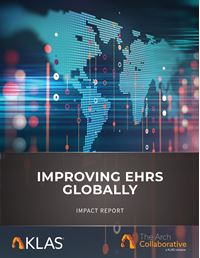Improving EHRs Globally
Today, achieving EHR satisfaction is a global endeavor as digitization of patient records becomes more and more common throughout the world. This report aims to increase awareness of the similarities and differences in EHR challenges faced by US and non-US health systems. To date, 189 organizations across the globe have measured the feedback of their clinicians (totaling >90,000 responses) and have received benchmarking data comparing them to similar organizations. 13 of these organizations are outside the United States. Do non-US health systems have a different perception of their EHR compared to US organizations? And if there are differences, what can each group learn from the other?
In most ways, US and non-US health systems have similar experiences with their EHRs. For both groups, system reliability and internal integration are the two aspects of the EHR generating most satisfaction. The areas where more significant differences appear are efficiency (non-US health systems
Access the feedback of
500,000+ clinicians worldwide
Access the feedback of
500,000+ clinicians worldwide
Here is my information:


While there are some key differences, like the impact of EHR personalizations, KLAS has confirmed that non-US health systems follow Arch Collaborative trends for two of the three pillars of success: EHR education and a culture of shared ownership.
When it comes to initial training, US and non-US clinicians have very similar experiences. Just over half of the clinicians in each group agree initial training prepared them well; US clinicians are just slightly more likely to strongly agree.
This trend persists for ongoing training, which US and non-US clinicians agree is sufficient in equal numbers (53% in each group). Again, US clinicians are slightly more likely to strongly agree ongoing training is sufficient.
Clinicians’ relationships with and trust in IT leadership are similar throughout the world. Building a symbiotic relationship and creating shared ownership between the clinicians who use the EHR and the IT and informatics personnel who support the EHR is essential for achieving EHR satisfaction, no matter the geography.


The biggest difference between US and non-US health systems is in adoption of EHR personalization tools. In the US, personalization tools help clinicians get data in and out of the EHR more quickly in the face of stringent documentation requirements. Outside the US, these requirements are less burdensome, so clinicians need less EHR personalization to be efficient. However, if the global community were to see increased regulatory burdens similar to those in the US, the use of EHR-personalization tools would likely have a significant impact on EHR satisfaction.


Report Non-Public HTML Body
Report Public HTML Body
Featured in Learning Tracks
Topics
Report Topics
EHR Personalization, Onboarding EHR Education, Ongoing EHR EducationThis material is copyrighted. Any organization gaining unauthorized access to this report will be liable to compensate KLAS for the full retail price. Please see the KLAS DATA USE POLICY for information regarding use of this report. © 2019 KLAS Research, LLC. All Rights Reserved. NOTE: Performance scores may change significantly when including newly interviewed provider organizations, especially when added to a smaller sample size like in emerging markets with a small number of live clients. The findings presented are not meant to be conclusive data for an entire client base.



